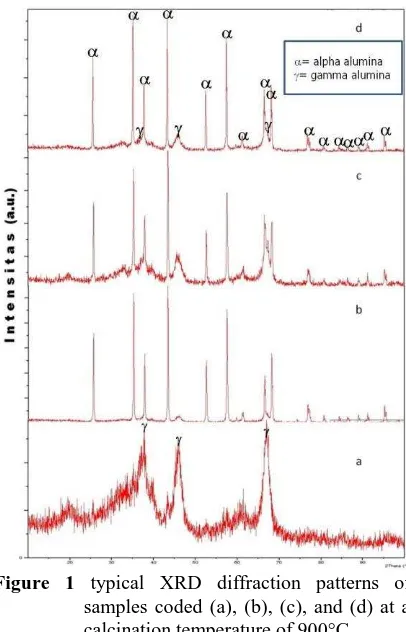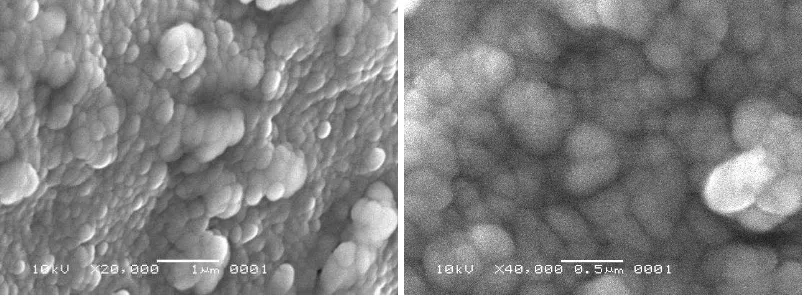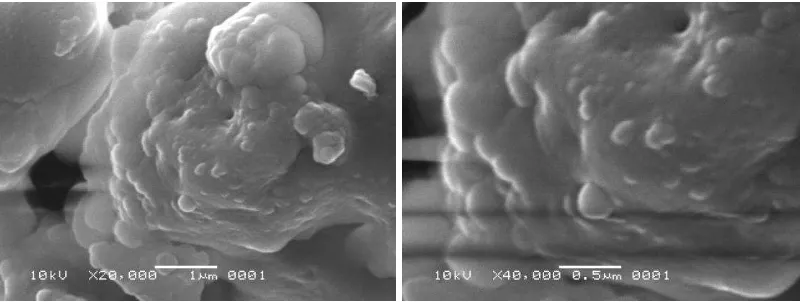Rifki Septawendar et al. 26
Effect of an organic template in the morphology and
microstructure of nano alumina
Rifki Septawendar
1,*, Soesilowati
1, Diana Rakhmawaty Eddy
21
Center for Ceramics, Ministry of Industry,
Jln. Akhmad Yani 392, Bandung 40272, West Java, Indonesia
2Inorganic Chemistry Laboratory, Department of Chemistry, Universitas Padjadjaran,
Jln. Raya Bandung-Sumedang km. 21 Jatinangor, Sumedang, West Java, Indonesia *Corresponding author: [email protected]
Abstract
Many methods have been proposed to prepare nano oxide materials; one of them is using organic templates. In this study, investigation on the effect of an organic template in the morphology and microstructure of nano alumina was conducted using a scanning electron microscope. Meanwhile, an organic template used was technical grade disachcharide. Aluminum salt solution was mixed with disachcharide compoud at various weight concentrations, namely 0%, 5%, 10%, and 15% (w/w). The mixture was then heated at 100°C producing caramel precursors. The precursors were calcined at 900°C for 5 hr. The final products were then characterized by XRD and SEM. XRD results show that two dominant phases of alumina are formed in every alumina sample, namely - and -Al2O3. SEM images show that after calcination treatment of alumina samples at 900°C, alumina without template has a homogenous morphology and larger particles ranging from 100 to 300 nm in size, whereas alumina with various template concentrations have a homogenous morphology and smaller particle sizes below 100 nm.
Keywords: organic template, concentration, morphology, microstructure, nano alumina
Introduction
Extensive researches in nanoparticle including synthesis method, analysis and characterization on structural, chemical, and physical properties and their application in vaious technologies; are very fundamental and important in nanoscience and nanotechnology (Niederberger & Pinna, 2009). Many synthesis methods on nanomaterial have been proposed to give novel new materials with superior properties. Controlled structures, large interfacial areas, power density and other unique characteristics are examples of the superiority of the properties of nanomaterials so that they can access new and improved properties and functionalities. Also, nanomaterials will have characteristics such as a particle size ranging of about 10-100 nm, a narrower grain size distribution, will be more homogenous chemically and physically, the chemical composition and the purity of materials can be controlled, the morphology also can be controlled, and a lower sintering temperature (Edwin et. al., 2009; Lee et al., 2007; Roco & Bainbridge, 2001).
Preparation of nanopowder in a large quantity with relatively low production cost is easy to be applied using material precursor from gases phase, whose the particle size produced are very uniform
and homogenous. Nevertheless, synthesis of nanopowder from a liquid phase is more flexible because some variables can be controlled such as the structure, the chemical composition, and the morphology shape of nanopowder. Synthesis route by a liquid phase can be conducted by co-precipitation method, hydrolytic and non-hydrolytic sol-gel, hydrothermal process, solvothermal, templating process, and biomimetic approach (Niederberger & Pinna, 2009).
Rifki Septawendar et al. 27
Materials and Methods
Materials and instruments
High purity grade aluminum sulphate octadecahydrate, ammonia solution, and 65% nitric acid were obtained from Merck; whereas technical grade disachcharide compound was obtained from a local market. Instruments used in this research were a Heraus electrical furnace, an X-Ray Phillips PANalytical, and a JEOL (JSM-35C) scanning electron microscope.
Methods
An appropriate amount of aluminum salt was dissolved in aquadest and then stirred until homogeneous and produced clear solution. An excess ammonia solution was added into the solution until producing aluminum hydroxide sols. After that, the sol was reacted with 65% nitric acid in stoichiometry producing aluminum nitrate solution. In advance, the organic template, disachcharide compound was added gradually into the solution while being stirred until producing a homogeneous solution. However, a template concentration was varied based on the weight of alumina namely, 0% (a), 5% (b), 10% (c), and 15% (d). The solution was heated to 100°C, thus forming caramel. Caramel was then dried in an oven at 200°C to produce black charcoal precursors. Then, the precursors were calcined at 900°C, producing ultrafine white powder. Finally, the calcined powder was characterized by X-ray diffraction and scanning electron microcsopy studies.
Results and Discussion
Identification mineral phases of alumina by XRD analysis
Typical diffraction patterns of each sample are presented in Figure 1 (a), (b), (c) and (d). The XRD results showed that the different of disachcharide template concentrations of each sample has produced different dominant phase of alumina. Nevertheless, alumina phases formed in every samples commonly consisted of -Al2O3 and
-Al2O3 with different concentrations. Sample (a)
without template addition produced -Al2O3 phase
about 72.8% and -Al2O3 phase about 28.2%.
Sample (b) with 5% template addition produced -Al2O3 phase about 2.9% and -Al2O3 phase about
97.1%. Sample (c) with 10% template addition produced -Al2O3 phase about 18.3% and -Al2O3
phase about 81.7%. Sample (d) 5% with 15%
template addition produced -Al2O3 phase about
9.9% and -Al2O3 phase about 90.1%.According to
these XRD results, the organic template addition on the nano alumina preparation significantly increases the concentration of -Al2O3 phase produced, with
its average content accounted is above 80% of the total alumina formed.
Figure 1 typical XRD diffraction patterns of
samples coded (a), (b), (c), and (d) at a calcination temperature of 900°C
A quantitative analysis of difractogram patterns for each sample including composition and crystal sizes of alumina phases formed was applied and assisted using an XRD software. The Scherrer equation was implemented to calculate crystallite sizes of alumina phases in every sample at a calcination temperature of 900°C based on the main peaks of XRD patterns from Figure 1 (Kwon et al., 2002).
Where D is the crystal size, K is a shape factor with a value of 0.9-1, λ is the wavelength of the X-rays (1.54056 Å), and β is the value of the full width half maximum (FWHM).
According to the Scherrer equation, sample (a) has average crystallite sizes of -Al2O3 and -Al2O3
Rifki Septawendar et al. 28
about 7 nm and 53 nm, respectively. Sample (c) has average crystallite sizes of -Al2O3 and -Al2O3
about 8 nm and 48 nm, respectively; and sample (d) has average crystallite sizes of -Al2O3 and -Al2O3 crystal size is becoming smaller. By contrast, if the peak of an XRD pattern is becoming sharper, crystal size will be bigger and its crystallinity will be better. This is in conformity with the XRD patterns of the alumina nanopowder in Figure 1 (Septawendar et. al., 2011).
Effect of an organic template in the morphology and the microstructure of alumina powder
Typical SEM images of each alumina sample are presented in Figures 2-5.
SEM characterization results of sample (a) in Figure 2 show very homogenous morphology of alumina particles having quite larger grain sizes, ranging from 100 to 300 nm. SEM images in Figure 3 present the microstructure of sample (b), showing homogenous particle morphology and smaller grains from 100 to 150 nm in size. SEM results in Figures 3 and 4 show the microstructure and morphology of samples (c) and (d). Sample (c) has compact particle morphology and smaller grains than particles of sample (a) and (b) below 100 nm. Nevertheless, SEM images of sample (d) show fine microstructure and much smaller alumina grains than other samples, having sizes below 100 nm.
The average particle size of alumina in sample (d) is much smaller and finer than other samples especially sample (a), which without template addition in the alumina preparation. When a salt of aluminum sulphate is dissolved in distilled water, a hydrated aluminum ion would be produced from aqueous aluminum sulphate in the ion complex form of aluminum hexaaqua ion, where the reaction is as follows (Shevla, 1979; Septawendar, Setiati,
catalyst, until the white sol of aluminum hydroxide (Al(OH)3) was formed. The addition of 65% nitric
acid solution to the mixture was to convert
aluminum hydroxide to aluminum nitrate. It was noted that aluminum nitrate was a very reactive and the best Al inorganic precursor. Aluminum nitrate shows good solubility in water medium and hydrolyzes strongly to produce an acidic medium required for the gelation. Thus, catalyst such as ammonia is not needed in this process. Owing the spontaneous decomposition of aluminum nitrate during gelation, the pH increases continously during the process, supporting the hydrolysis and condensations reaction. Nevertheless, the disadvantage of nitric acid addition is leaving nitrate content in the mixture, which escapes as nitrous gases during gelation and heat treatment (Sinko & Nemenyi, 2004).
Al(OH)3(sol) + 3HNO3 (l) Al(NO3)3 (aq) + 3H2O (3)
Hydrolysis reaction of aluminum nitrate (Brinker & Scherrer, 1990):
[Al(H2O)6]3++H2O [Al(OH)h(H2O)6-h](3-h)++H3O+(4)
hH3O +
+ hOH- 2hH2O (5)
where h is defined as the molar ratio of hydrolysis, is equivalent to the OH:Al ratio according to the net reaction (4 & 5). Condensations mechanism undergoes via olation and oxolation reactions between the two singly hydrolized monomers or more resulting in polynuclear hydroxides or oxo-hydroxides. The value of h = 2 or 3 is significant only in a very dilute solution (Brinker and Scherrer, 1990). Therefore, the complex from of a singly hydrolized monomer might be predicted as
[Al(OH)2(H2O)4]4+ or[Al(OH)3(H2O)3]3+.
Since the condensation reaction of the hydrolized monomers continously undergoes, the polynuclear hydroxides or oxo-hydroxide will be more produced; consequently, the crystallization process of alumina occurs in high speed rate and could not be controlled, thus producing larger crystallites and larger particles in the final alumina product. However, this phenomenon could be prevented by inhibiting the condensations reaction through the addition organic molecules (Brinker & Scherrer, 1990).
Rifki Septawendar et al. 29
hindrance provided by the olygomer (Septawendar et. al., 2011).
Nevertheless, since the system was an acidic medium, some disachcharide molecules were also hydrolized producing monosachcharides. Monosachcharides also coated the hydrolized aluminum monomers as well as the disachcharide, with the same mechanism. Therefore, various types of reaction mechanism between the hydrolized aluminum monomers or dimers and disachcharides or monosachcharides could be happened. One of them could be assumed as follow (Septawendar et. al., 2011):
A total reaction is assumed as follow:
2Al(NO3)3(aq) + C12H22O11 (s) Al2O3(s)+ 6NO2(g)
+ 8O2(g)+ [12C (s) + 11 H2O(g)](product transition) (7)
the product transition in the reaction covered alumina particle surfaces, restricted the grain contact among the nucleated Al2O3, restrained the
crystallite growth during heating treatment, and was burnt as carbon dioxide gases and vapor at higher temperature.
Another assumption, the concentration of Al3+ ions of the precursor with a greater amount of the template compound will be lower during the course of the phase transformation. With an excess template compound concentration, this compound will be completely distributed on the salt or hydroxide surfaces so that the binding distance or particle density will be wider, because the template restricts the grain contact among the nucleated Al2O3 and restrains the crystallite growth. As the
template content decreased, the crystalline grains grown substantially; more sintering necks and interconnections were formed (Septawendar et al., 2011). However, Figures 2-5 show scanning electron microscopy images of nano alumina samples coded (a), (b), (c), (d) in which an appreciable formation of agglomerates after thermal treatment at 900°C can be seen. Fine particles, particularly nanoscale particles, because they have large surface areas, often agglomerate to form either lumps or secondary particles to minimize the total surface area or interfacial energy of the system. The agglomeration refers to the adhesion of the particles to each other because of van der Waals forces of attraction, which are significantly higher in nanoparticles (Santos et al., 2008).
Rifki Septawendar et al. 30 Figure 3 SEM image of sample (b) at 900°C
Figure 4 SEM image of sample (c) at 900°C
Figure 5 SEM image of sample (d) at 900°C
Conclusions
The organic template addition on the nano alumina preparation significantly increases the concentration of -Al2O3 phase produced, with its
average content accounted is above 80% of the total alumina formed. However, the crystallite of alumina phases in every sample with or without template addition forms in nanometer dimension.
Rifki Septawendar et al. 31
References
Brinker, C.J. & G.W. Scherer. 1990. Sol-Gel
Science: the physics and chemistry of sol-gel processing. Academic Press Inc., San Diego,
Edwin, F., R. Septawendar, B. S. Purwasasmita, Suhanda, & L. Nurdiwijayanto. 2009.
Synthesis and characterization of α-alumina nano powder with oryza sativa pulp as by precursor calcining process. J. Riset Industri.
3(3): 190-194.
Kwon, Y. J., K. H. Kim, C. S. Lim, & K. B.
Shim. 2002. Characterization of ZnO
nanopowders synthesized by the polymerized complex method via an organochemical route. J. Ceram. Proc. Res. 3(3):146-149,
Lee, Y-C., S-B. Wen, & L. Wenglin. 2007. Nano
α-Al2O3 powder preparation by calcining an
emulsion precursor. J. Am. Ceram. Soc. 90(6): 1723 – 1727.
Niederberger, M. & N. Pinna. 2009. Metal Oxide
Nanoparticles in Organic Solvents: synthesis, formation, assembly, and application. Springer. London.
Roco, M. C. & W. S. Bainbridge. 2001. Societal
implications of nanoscience and nanotechnology, in NSET Workshop Report, National Science Foundation. Virginia.
Santos, V., M. Zeni, C.P. Bergmann, & J.M. Hohemberger. 2008. Correlation between
thermal treatment and tetragonal/monoclinic nanostructuredzirconia powder obtained by sol– gel process. Rev. Adv. Mater. Sci. 17: 62-79. Septawendar, R., B.S. Purwasasmita, Suhanda,
L. Nurdiwijayanto, & F. Edwin. 2011.
Nanocrystalline ZrO2powder preparation using
natural cellulosic material. J. Ceram. Proc. Res.
12(1):110-113.
Septawendar, R., Suhanda, & F. Edwin. 2011. Nanocrystalline -Al2O3 powder preparation
with sucrose as a template through a chemical route. J. Ceram. Proc. Res.12(4): 365-370. Septawendar, R., A. Setiati, & S. Sutardi. 2011.
Low-temperature calcination at 800°C of alumina-zirconia nanocomposites using sugar as a gelling agent. Cerin.37(8): 3747-3754.
Shevla, G. 1979. Vogel’s textbook of macro and
semimicro qualitative inorganic analysis. 5th edition, Longman Inc., New York.


